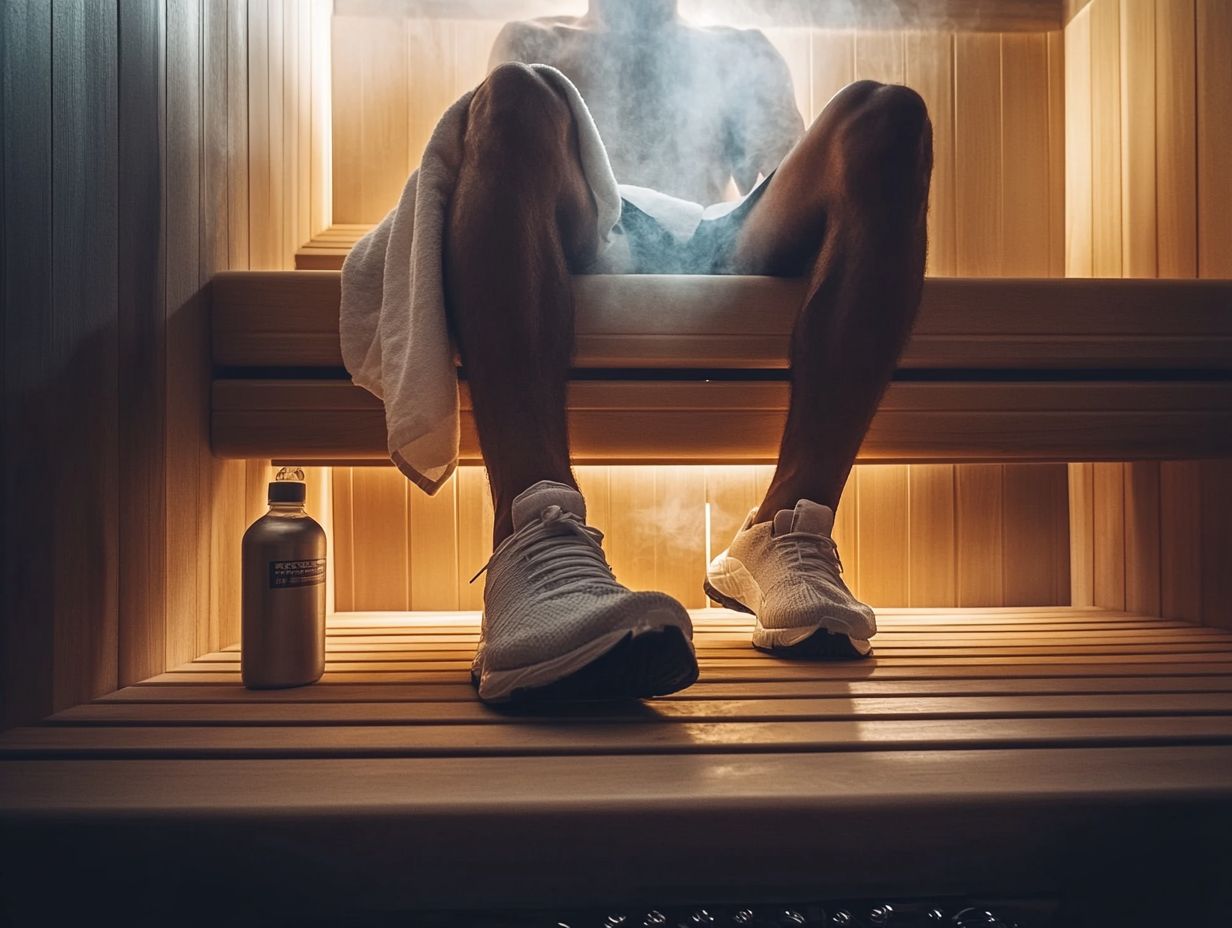Can I Use a Sauna After a Workout?
Saunas have long been celebrated for their relaxing and rejuvenating properties, but have you ever considered how they can elevate your post-workout recovery? Let s explore the different types of saunas together and discover their benefits after exercise!
This article highlights the various types of saunas, their benefits after exercising, and outlines essential safety precautions to ensure you remain healthy while indulging in their soothing effects.
You’ll uncover valuable tips for seamlessly incorporating sauna sessions into your routine, along with alternative relaxation methods. Immerse yourself in this exploration to discover how the warmth of a sauna can enhance your fitness journey!
Contents
Key Takeaways:

- Using a sauna post-workout helps relax muscles and speeds up recovery, making it a valuable addition to your routine.
- Saunas can aid in detoxification and weight loss, but it’s essential to follow safety precautions to avoid potential risks related to chronic conditions like heart disease and hypertension.
- Timing and frequency for sauna use after a workout can vary, so it’s best to consult with a healthcare professional or sauna specialist for personalized advice.
Understanding Saunas
Saunas have long been celebrated for their healing and health benefits, offering an exceptional environment that fosters relaxation and well-being. Whether you prefer the traditional Finnish sauna, the innovative infrared sauna, or the refreshing steam room, the diverse temperature and humidity levels can greatly influence your cardiovascular health and hydration while managing dehydration risk.
Regular sauna sessions can help manage chronic conditions and mitigate the risk of dehydration, making it an invaluable asset to your wellness journey. Grasping the nuances of the various sauna types, including the infrared sauna and steam room, and their unique advantages is essential for tapping into their full potential in enhancing your overall health.
Types of Saunas and How They Work
Different types of saunas provide unique experiences and benefits tailored to your individual preferences and health goals.
Take the traditional Finnish sauna, for example. Here, you can expect temperatures ranging from 150 to 195 degrees Fahrenheit, with low humidity that invites a vigorous sweat. This promotes detoxification and enhances blood circulation, giving your cardiovascular health a boost.
On the flip side, there are infrared saunas, which operate at a more moderate range of 120 to 150 degrees Fahrenheit. The infrared rays penetrate deeper into your skin, aiding in muscle recovery and pain relief an appealing option for anyone with an active lifestyle.
Then there are steam rooms, where humidity levels climb, offering myriad benefits for respiratory health while also providing a delightful boost to skin hydration.
Each sauna type brings its own distinctive physiological effects, contributing to a holistic approach to your wellness journey.
Benefits of Using a Sauna After a Workout
Incorporating a sauna session after your workout can significantly elevate your recovery and overall well-being, transforming it into an essential element of your fitness routine.
The enveloping heat fosters enhanced blood circulation, which helps deliver vital nutrients and oxygen to fatigued muscles for better recovery.
Saunas also help replenish lost fluids and electrolytes, supporting cardiovascular health and enhancing endurance performance.
This post-workout ritual accelerates recovery, alleviates joint pain, and reduces muscle soreness, optimizing your fitness journey and maximizing your workout results.
Make sauna sessions a vital part of your fitness routine! Experience faster recovery, less muscle soreness, and improved performance today! To ensure a safe experience for the whole family, consider learning how to teach kids about sauna safety and maintenance.
Improved Recovery and Muscle Relaxation

One of the primary benefits of using a sauna is the remarkable enhancement of your muscle recovery and relaxation after intense physical activity. The heat eases muscle tension and reduces joint pain, significantly improving your overall performance.
By promoting cardiovascular health through an elevated heart rate, saunas help your body recover more efficiently. This increased heart rate mimics moderate exercise, boosting blood flow and delivering oxygen and vital nutrients to exhausted muscles.
Research shows that regular sauna sessions can lower levels of lactate, a substance that builds up in muscles during exercise, causing soreness. This reduction speeds up your recovery times.
The soothing warmth encourages the release of endorphins, your body s natural painkillers, providing relief from discomfort. You may even notice improved stamina and endurance, leading to better athletic performance.
Detoxification and Weight Loss
Saunas are celebrated for their detoxification benefits. They help eliminate toxins through the wonderful process of sweating.
This natural response cleanses your body and aids in weight loss since the heat boosts your metabolic rate and burns calories. However, be aware of the potential dehydration risks that come with extensive sweating during sauna sessions.
When you immerse yourself in sauna therapy, the elevated temperatures stimulate your sweat glands, resulting in increased perspiration. This helps flush out harmful substances from your skin and bloodstream.
As you sweat, you might experience short-term weight loss due to fluid loss. Just remember, this weight reduction is often temporary and shouldn t be confused with fat loss.
Finding the right balance between enjoying health benefits and managing dehydration is crucial. Therefore, proper hydration before and after your sauna experience is essential.
By staying hydrated, you can fully harness the advantages of your sauna sessions while minimizing potential health risks.
Safety Precautions When Using a Sauna
While saunas offer a range of health benefits, embracing safety precautions is essential. This is particularly true for individuals with chronic conditions like heart disease and hypertension.
Prioritizing proper hydration is crucial to combat dehydration. Be mindful of the time spent in the sauna, adjusting it according to your comfort and health status.
By following these safety measures, you can ensure a safe and enjoyable sauna experience while maximizing the benefits.
Possible Risks and How to Avoid Them
Be aware of the potential risks associated with sauna usage, such as dehydration and complications for individuals with chronic conditions like heart disease and hypertension.
Inadequate hydration can worsen existing health issues, leading to symptoms like dizziness and even serious cardiovascular events.
Health professionals emphasize understanding your body and recognizing warning signs, especially if you have conditions that affect blood pressure regulation.
Monitor how your body responds while in the sauna and take breaks as needed. Prioritizing hydration by consuming water or electrolyte-rich beverages can significantly reduce these risks.
Discussing sauna use with your healthcare provider can provide personalized insights and recommendations, especially for those with chronic conditions like heart disease and hypertension.
How to Incorporate Sauna Use into Your Post-Workout Routine

Incorporating sauna use into your post-workout routine can significantly enhance your fitness results. It offers notable recovery and relaxation benefits.
Establishing an effective timing and frequency regimen is crucial. Typically, 15 to 30-minute sauna sessions following intense workouts can optimize muscle recovery, boost cardiovascular health, and improve hydration levels while reducing the risk of dehydration.
By strategically integrating sauna sessions, you can maximize the benefits of your fitness regimen while actively managing your hydration and mitigating dehydration risks.
Timing and Frequency Recommendations
Optimal timing for your sauna sessions post-workout is essential to fully harness the recovery and health benefits. Enter the sauna within 30 minutes after exercising, giving your body just enough time to cool down slightly before embracing the heat.
Aim for 2-3 sessions each week. This approach strikes the perfect balance for improved muscle recovery and hydration, while avoiding the pitfalls of dehydration.
Incorporating sauna sessions right after your workouts can significantly boost blood flow, aiding muscle repair and alleviating soreness. If you’re wondering about the safety of sauna use for younger individuals, you might ask, can children use a sauna? Tune in to your body; if you’re feeling fatigued, adjust the duration of your sauna time, which typically falls between 15 to 20 minutes.
Hydration is key. Be sure to drink water before and after each session, as your body will lose fluids through sweat. To elevate the effects, consider enjoying drinks with electrolytes to replenish lost minerals and maintain balance. For families, it’s essential to follow safety practices; refer to sauna safety guidelines for family use. A mindful approach to your sauna sessions can enhance your overall wellness.
Alternatives to Saunas for Post-Workout Relaxation
While saunas offer remarkable benefits for post-workout relaxation and muscle recovery, there are several equally effective alternatives to consider.
Techniques such as foam rolling, stretching, and the use of ice baths or hot tubs can significantly alleviate muscle soreness and tension. Incorporating these methods into your post-workout routine could elevate your recovery experience, making them worthy companions to your sauna sessions.
Other Methods for Muscle Recovery and Relaxation
Besides those rejuvenating sauna sessions, you can explore several other methods that effectively enhance muscle recovery and relaxation. Techniques like foam rolling work wonders to alleviate muscle tightness, while ice baths are renowned for reducing inflammation and soreness. Hot tubs provide soothing heat that relaxes your muscles and promotes blood flow.
Another excellent recovery method is active stretching, which improves flexibility and circulation, making it a perfect complement to your sauna routine. Don t overlook massage therapy whether you opt for deep tissue or Swedish this can relieve tension and improve muscle function, significantly enhancing your overall recovery.
Proper hydration is essential in this mix; electrolytes play a crucial role in maintaining muscle function, especially during rigorous recovery activities. Each of these methods brings distinct advantages. When combined with sauna sessions, they create a comprehensive recovery strategy that supports your physical health and overall wellness.
Frequently Asked Questions

Can I Use a Sauna After a Workout?
Yes, using a sauna after a workout offers many recovery benefits.
How long should I wait to use a sauna after a workout?
It is recommended to wait at least 5-10 minutes after your workout before entering a sauna. This allows your body to cool down and prevents overheating.
Try incorporating sauna sessions into your routine and share your experiences!
What are the benefits of using a sauna after a workout?
A sauna session after your workout relaxes and soothes sore muscles. It boosts circulation and speeds up recovery.
Can using a sauna after a workout help with weight loss?
You can lose water weight in a sauna, but this isn t a lasting weight loss method. Focus on regular exercise and a balanced diet for real results.
Are there any risks to using a sauna after a workout?
Using a sauna can have risks. Be cautious of dehydration, overheating, and strain on your heart. Always listen to your body and limit your time inside.
Can anyone use a sauna after a workout?
Most healthy people can safely use a sauna after exercising. However, if you have heart issues or other health concerns, check with your doctor first. Pregnant women and children should avoid saunas too.






